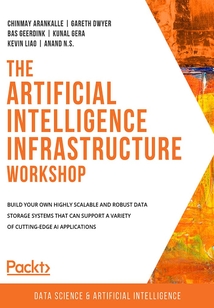舉報 

會員
The Artificial Intelligence Infrastructure Workshop
Socialnetworkingsitesseeanaverageof350millionuploadsdaily-aquantityimpossibleforhumanstoscanandanalyze.OnlyAIcandothisjobattherequiredspeed,andtoleverageanAIapplicationatitsfullpotential,youneedanefficientandscalabledatastoragepipeline.TheArtificialIntelligenceInfrastructureWorkshopwillteachyouhowtobuildandmanageone.TheArtificialIntelligenceInfrastructureWorkshopbeginstakingyouthroughsomereal-worldapplicationsofAI.You’llexplorethelayersofadatalakeandgettogripswithsecurity,scalability,andmaintainability.Withthehelpofhands-onexercises,you’lllearnhowtodefinetherequirementsforAIapplicationsinyourorganization.ThisAIbookwillshowyouhowtoselectadatabaseforyoursystemandruncommonqueriesondatabasessuchasMySQL,MongoDB,andCassandra.You’llalsodesignyourownAItradingsystemtogetafeelofthepipeline-basedarchitecture.AsyoulearntoimplementadeepQ-learningalgorithmtoplaytheCartPolegame,you’llgainhands-onexperiencewithPyTorch.Finally,you’llexplorewaystorunmachinelearningmodelsinproductionaspartofanAIapplication.Bytheendofthebook,you’llhavelearnedhowtobuildanddeployyourownAIsoftwareatscale,usingvarioustools,APIframeworks,andserializationmethods.
目錄(104章)
倒序
- 封面
- 版權信息
- Preface
- 1. Data Storage Fundamentals
- Introduction
- Problems Solved by Machine Learning
- Optimizing the Storing and Processing of Data for Machine Learning Problems
- Diving into Text Classification
- Looking at Terminology in Text Classification Tasks
- Designing for Scale – Choosing the Right Architecture and Hardware
- Using Vectorized Operations to Analyze Data Fast
- Summary
- 2. Artificial Intelligence Storage Requirements
- Introduction
- Storage Requirements
- Data Layers
- Raw Data
- Historical Data
- Streaming Data
- Analytics Data
- Model Development and Training
- Summary
- 3. Data Preparation
- Introduction
- ETL
- Data Processing Techniques
- Streaming Data
- Summary
- 4. The Ethics of AI Data Storage
- Introduction
- Summary
- 5. Data Stores: SQL and NoSQL Databases
- Introduction
- Database Components
- SQL Databases
- MySQL
- NoSQL Databases
- MongoDB
- Cassandra
- Exploring the Collective Knowledge of Databases
- Summary
- 6. Big Data File Formats
- Introduction
- Common Input Files
- Choosing the Right Format for Your Data
- Introduction to File Formats
- Summary
- 7. Introduction to Analytics Engine (Spark) for Big Data
- Introduction
- Apache Spark
- Apache Spark and Databricks
- Understanding Various Spark Transformations
- Understanding Various Spark Actions
- Best Practices
- Summary
- 8. Data System Design Examples
- Introduction
- The Importance of System Design
- Components to Consider in System Design
- Examining a Pipeline Design for an AI System
- Making a Pipeline System Highly Available
- Summary
- 9. Workflow Management for AI
- Introduction
- Creating Your Data Pipeline
- Challenges in Managing Processes in the Real World
- Automating a Data Pipeline
- Automating Asynchronous Data Pipelines
- Workflow Management with Airflow
- Summary
- 10. Introduction to Data Storage on Cloud Services (AWS)
- Introduction
- Interacting with Cloud Storage
- Getting Started with Cloud Relational Databases
- Introduction to NoSQL Data Stores on the Cloud
- Data in Document Format
- Summary
- 11. Building an Artificial Intelligence Algorithm
- Introduction
- Machine Learning Algorithms
- Model Training
- Gradient Descent
- Getting Started with PyTorch
- Mini-Batch SGD with PyTorch
- Summary
- 12. Productionizing Your AI Applications
- Introduction
- pickle and Flask
- Deploying Models to Production
- Model Execution in Streaming Data Applications
- Summary
- Appendix
- 1. Data Storage Fundamentals
- 2. Artificial Intelligence Storage Requirements
- 3. Data Preparation
- 4. Ethics of AI Data Storage
- 5. Data Stores: SQL and NoSQL Databases
- 6. Big Data File Formats
- 7. Introduction to Analytics Engine (Spark) for Big Data
- 8. Data System Design Examples
- 9. Workflow Management for AI
- 10. Introduction to Data Storage on Cloud Services (AWS)
- 11. Building an Artificial Intelligence Algorithm
- 12. Productionizing Your AI Applications 更新時間:2021-06-11 18:35:51
推薦閱讀
- Aftershot Pro:Non-destructive photo editing and management
- Learning Cocos2d-x Game Development
- 龍芯應用開發標準教程
- 深入淺出SSD:固態存儲核心技術、原理與實戰
- BeagleBone Robotic Projects
- “硬”核:硬件產品成功密碼
- 3D Printing Blueprints
- 基于網絡化教學的項目化單片機應用技術
- 單片機項目設計教程
- Mastering Quantum Computing with IBM QX
- 微服務實戰
- 微服務架構基礎(Spring Boot+Spring Cloud+Docker)
- 從企業級開發到云原生微服務:Spring Boot實戰
- 微服務架構實戰:基于Spring Boot、Spring Cloud、Docker
- 計算機組裝與維護
- Arduino項目開發:智能控制
- 電腦組裝與硬件維修從新手到高手
- OpenCV 4 Computer Vision Application Programming Cookbook(Fourth Edition)
- Mastering TensorFlow 1.x
- Ouya Unity Game Development
- 阿里巴巴Java開發手冊(第2版)
- Lumion 3D Cookbook
- Direct3D Rendering Cookbook
- IntelliJ IDEA Essentials
- 計算機組裝與維修技術(第2版)
- 量子霸權
- KVM實戰:原理、進階與性能調優
- 單片機從入門到實戰(視頻自學版)
- Python GUI Programming Cookbook
- 數據存儲架構與技術(第2版)

